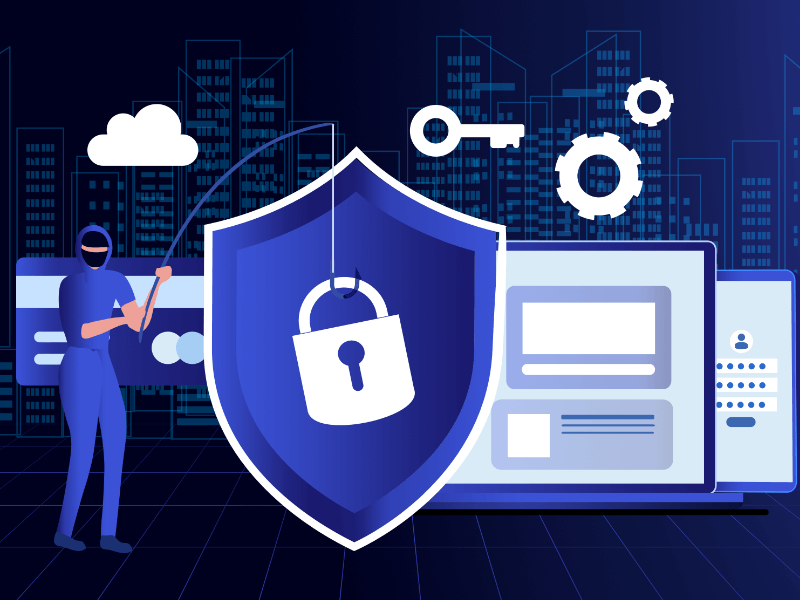The Ultimate Guide to Phishing and How to Stop Phishing Attacks
Phishing has been one of the most dangerous cyber threats for businesses for quite a while. The damage that a simple phishing attack can cause to an unprotected system is beyond limits since it can provide an attacker with as much access as a top-level executive of the company.
Therefore, phishing is the first thing that small business owners look to eliminate when creating a cybersecurity policy. However, before learning how to stop phishing attacks, it is important to understand what they actually are.
This article will provide an in-depth insight into what are phishing attacks, how they function, types of phishing attacks, and how you can stop phishing attacks from causing any damage to your company.
What is a Phishing Attack?
Phishing attacks generally involve the attacker stealing the personal credentials of an individual by pretending to be a trusted person, website, or organization. There are many different types of phishing attacks so the exact working process of the attack can vary depending on which type of attack is used. These attacks can come from many different methods such as emails, social media messages, work-related software, or any other application.
Phishing is the single most serious cyberattack that also opens possibilities to other data breaches and malware infections. According to a Verizon Data Breach Investigations Report, 1 in 4 data breaches is due to phishing attacks. These statistics are even supported by official government reports such as FBI cybercrime statistics which regard phishing as the most reported cyberattack in the US.
How Do Phishing Attacks Work?
In a phishing attack, the attacker sends the receiver a message that appears to be from a trusted source, such as a supplier, vendor, colleague, friend, or even a platform that the receiver uses. The message contains a link that can appear genuine, but it actually takes the receiver to the attacker’s tampered website.
The website asks the user for their login credentials, payment details, or any other personal information. Once the user enters these details, they are sent to the attacker.
Since phishing attacks work by slight changes in the web addresses, it is possible for the victim to identify these attacks. However, for business employees who are clicking hundreds of links each day, inspecting each link individually is not really feasible.
What are the Different Types of Phishing Attacks?
All phishing attacks are based on deceiving the receiver and making them think that the attacker is a genuine person. There are various forms in which attackers carry out these attacks, leading to many different types of phishing attacks. Some of the common types are:
Spear Phishing
Unlike generic phishing attacks, spear phishing is a very targeted type of phishing attack. It is designed keeping in mind a particular company or individual. The attacker first researches the individual through social engineering methods, and then sends out emails or messages to the individual that appear very genuine.
The emails can either take to web pages that ask for personal information or contain links that will contaminate the target’s computer with malware such as ransomware.
Vishing
Vishing attacks are a type of phishing attacks done through phone calls. The phone calls add more human interaction to the attack, making the attacker seem like a reliable party. Additionally, the calls are made from a spoof ID to create a sense of genuinity. The attacker can make the matter seem urgent or vital, making the victim divulge personal information to them, such as login credentials or bank details.
Whaling
Whaling attacks are aimed towards senior executives and managers of a company. This is because senior executives have more access to the company’s resources. These attacks take a lot of effort and appear in a corporate tone. It is visually very difficult to identify these phishing emails and messages since the attacker goes to extra lengths to conceal the malicious elements.
Smishing
Smishing attacks are done through SMS messages sent out to company’s employees. These messages contain links that usually ask for bank credentials or other financial data such as credit card credentials. These can be either mass sent or targeted towards a particular individual.
Clone Phishing
Clone phishing takes a legitimate email and completely duplicates it, while replacing a particular element with a malicious link. The employees have encountered the genuine email before considering the cloned email to be genuine as well. However, once they click on it and enter the required data, it is transmitted to the attacker.
How to Protect Against Phishing Attacks?
There are many ways to protect against phishing attacks. Here is what you can do to ensure that phishing attacks do not bother your company at any time in the future:
Using Tekkis’s Protection Layers
Tekkis Cybersecurity services can design a dedicated layer around your network that can identify and block all malicious emails and messages. This is done by using a combination of dedicated email filtering services along with customized security solutions that your organization requires.
The protection service is high-tech and used by many businesses throughout the US that value their IT security. You can get a free demo of the services before you commit to anything.
Staff Training
No IT security measure is good enough if your staff is leaving the gates open for attackers. Therefore, staff training is a must when it comes to protecting against phishing or any other cyberattack. Additionally, staff training is not a one-time thing. You need to hold regular staff training especially if your business contains sensitive user data, such as in the healthcare industry or financial organizations.
Once the staff is aware of the healthy cybersecurity practices, no attacker can penetrate your system regardless of how evolved the attacks are (provided you have enabled Tekkis’s protection layers).
Password Policy
Many companies make the mistake of using the same or similar password across multiple users and/or platforms. In this case, if one password is compromised due to phishing, every platform, service, and user is affected.
Therefore, enforce a strict password policy where no two passwords are similar. Additionally, use security measures such as two-factor authentication across the entire network.
How to Identify Phishing Emails?
As discussed earlier, there are many different types of phishing attacks. Therefore, the detection of phishing emails can be difficult as they can vary substantially. However, there are some warning signs that can denote a phishing email:
Spoof Email Addresses
Attackers sending phishing emails cannot really have a genuine email address. Therefore, they choose addresses with slight variations in spelling here and there. Therefore, look out if the email address is genuine or a spoofed one.
Spelling Errors
Genuine companies and vendors spend a lot of time and effort ensuring that the emails they send out are grammatically correct. However, attackers usually do not go through so much pain and effort. Therefore, if the email you receive has language and spelling issues here and there, it is often a red alert for phishing.
Attachments
Many people think that phishing only works by stealing your credentials. That is a wrong notion. Phishing can also work by making you click a link that infects your computer with malware.
Therefore, look out for the attachments that come with an email. In case there are unnecessary attachments, it can be loaded with viruses and malware. Only download and open attachments that come from a trusted and verified source.
Generics
Phishing emails that are sent out in bulk often contain generics instead of particular details. For instance, instead of stating your name, they might say ‘Dear User’ or something along those lines. If the email appears to have a lot of generics, it can be a phishing email.
Conclusion
Phishing is not a recent phenomenon, it has been around for more than a decade and it is going to be around for long. This is because of the high success rate of this attack and how easily employees fall into its trap.
If you are worried about phishing attacks compromising your business security, it might be high time to Talk to an Tekkis Expert. Tekkis has a team of cybersecurity professionals that are well aware of how cyber threats function and how to stop them. The best part is that instead of sticking you up with a standard product, tekkis designs a custom solution around your exact requirements.



